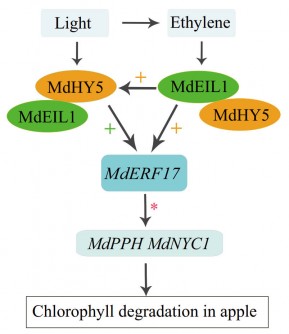Science
Scientists Uncover Pathway That Drives Apple Peel Degreening

Researchers from Shandong Agricultural University have made significant strides in understanding the transformation of apple peel color, a crucial aspect of fruit ripening. Their study, published on March 1, 2025, in the journal Horticulture Research, reveals a dual signaling pathway that links light and ethylene in the process of chlorophyll degradation. This discovery not only sheds light on how apples achieve their market-ready appearance but also holds potential implications for improving fruit quality in agriculture.
The research focuses on the role of chlorophyll degradation in fruit ripening, which is largely triggered by ethylene. The study highlights that while ethylene has been established as a key player in this process, the impact of light on chlorophyll breakdown had remained poorly understood. Previous studies identified MdERF17 as a downstream regulator in ethylene-induced chlorophyll degradation, but the interaction with light signaling factors warranted further investigation.
The research team identified two key transcription factors, MdEIL1 and MdHY5, which serve as the bridge between ethylene and light signaling. This interaction facilitates the activation of genes responsible for chlorophyll degradation, accelerating the loss of green color in apple peels.
Through a series of physiological assays and gene expression profiling, the researchers established a mechanistic model demonstrating how these factors operate. In their experiments, mature ‘Golden Delicious’ apples were treated with ethylene and its inhibitor, 1-MCP, under different light conditions. The results confirmed that ethylene exposure heightened chlorophyll loss, a process further intensified by light, emphasizing the synergistic effects of these signals.
Expression analysis showed that ethylene treatment induced MdEIL1, while light exposure activated MdHY5, leading to a joint increase in MdERF17 expression. Functional assays indicated that overexpression of either MdEIL1 or MdHY5 resulted in reduced chlorophyll content, while silencing these factors delayed peel degreening.
The molecular experiments employed various techniques, including yeast one-hybrid assays and chromatin immunoprecipitation (ChIP-qPCR), confirming that MdEIL1 directly binds to the promoters of both MdHY5 and MdERF17. The cooperative action of these proteins enhances the transcriptional activation of associated genes, forming a feedback module that accelerates chlorophyll degradation.
Prof. Shou-Qian Feng, the corresponding author of the study, stated, “Fruit coloration is one of the most visible indicators of ripening and market readiness. Our research shows that light and ethylene do not act independently but communicate through MdEIL1 and MdHY5 to fine-tune chlorophyll degradation.” This insight deepens the understanding of how external environmental factors and internal hormonal signals integrate to regulate fruit ripening.
The implications of this research extend beyond apples. By better understanding the MdEIL1–MdHY5 regulatory module, growers can potentially manage the coloration and postharvest quality of various fruits. Adjusting light exposure and ethylene treatments could enable the controlled ripening processes, enhancing uniform color transitions and ultimately improving market appeal and economic value for producers.
This study was supported by the National Key Research and Development Program of China and the National Natural Science Foundation of China. The findings contribute to ongoing efforts to optimize fruit quality through biotechnological advancements, with the potential to influence breeding programs across other horticultural crops.
For more detailed insights, the full study is available at Horticulture Research.
-

 Business1 week ago
Business1 week agoIconic Sand Dollar Social Club Listed for $3 Million in Folly Beach
-

 Politics1 week ago
Politics1 week agoAfghan Refugee Detained by ICE After Asylum Hearing in New York
-

 Health1 week ago
Health1 week agoPeptilogics Secures $78 Million to Combat Prosthetic Joint Infections
-

 Lifestyle1 week ago
Lifestyle1 week agoJump for Good: San Clemente Pier Fundraiser Allows Legal Leaps
-

 Science1 week ago
Science1 week agoResearchers Achieve Fastest Genome Sequencing in Under Four Hours
-

 Health1 week ago
Health1 week agoResearcher Uncovers Zika Virus Pathway to Placenta Using Nanotubes
-

 World1 week ago
World1 week agoUS Passport Ranks Drop Out of Top 10 for First Time Ever
-

 Entertainment1 week ago
Entertainment1 week agoJennifer Lopez Addresses A-Rod Split in Candid Interview
-

 Business1 week ago
Business1 week agoSan Jose High-Rise Faces Foreclosure Over $182.5 Million Loan
-

 Science1 week ago
Science1 week agoMars Observed: Detailed Imaging Reveals Dust Avalanche Dynamics
-

 Top Stories7 days ago
Top Stories7 days agoChicago Symphony Orchestra Dazzles with Berlioz Under Mäkelä
-

 World1 week ago
World1 week agoRegional Pilots’ Salaries Surge to Six Figures in 2025









